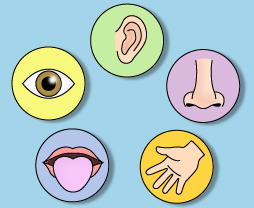Perceptual Training Ups Abstract Learning by 3X
 New York Times has an excellent article, Brain Calisthenics for Abstract Ideas, that describes successful application of perceptual learning to teaching K-12 math and science.
New York Times has an excellent article, Brain Calisthenics for Abstract Ideas, that describes successful application of perceptual learning to teaching K-12 math and science.
Our minds work best and learn automatically from rich sensory information. Perceptual learning typically involves the modification of one or more of our five senses through practice to discriminate specific sounds, detect particular patterns, feel subtle changes in texture and so on. Perceptual learning is inductive learning and results from lots of exposure and practice. It can evolve into expertise such as music appreciation, wine tasting, judging the quality of fabric by touch and so on.
Our minds struggle with abstract ideas and concepts such as equations, fractions and the notion of truth. Such things seems far from the rich sensory experience we are geared to process and are often taught in a top down fashion. Learn the abstract idea and then apply it to examples. Abstract learning is often deductive learning.
Ideally (at least from a cognitive design perspective), we would develop ways to teach and learn abstractions based on how our minds actually work best. That is exactly what the NYT article reports. Here is one example for learning fractions:
“On the computer module, a fraction appeared as a block. The students used a “slicer” to cut that block into fractions and a “cloner” to copy those slices. They used these pieces to build a new block from the original one — for example, cutting a block that represented the fraction 4/3 into four equal slices, then making three more copies to produce a block that represented 7/3. The program immediately displayed an ‘X’ next to wrong answers and “Correct!” next to correct ones, then moved to the next problem. It automatically adjusted to each student’s ability, advancing slowly for some and quickly for others. The students worked with the modules individually, for 15- to 30-minute intervals during the spring term, until they could perform most of the fraction exercises correctly.”
By using the slicer and cloner to manipulate embodied fractions on the computer students engage in perceptual learning but end up understanding fractions as an abstract concept. They learn to perceive fractions not reason about them conceptually.
Students that used this method tested 3 times better than a control group and demonstrated retention over 5 months.
Care must be taken to design modules to stimulate our built in perceptual learning abilities (e.g. tuning perceptual abilities based on patterns in sensory experience) rather than just show random examples or visually illustrate the abstract concept. A subtle difference and one that requires some skill in cognitive engineering and design.
January 16th, 2014 at 12:25 pm
Click On this website…
Cognitive Design » Blog Archive » Perceptual Training Ups Abstract Learning by 3X…
November 30th, 2014 at 3:22 am
http://www.ugg-boot-outlet.com…
Cognitive Design » Blog Archive » Perceptual Training Ups Abstract Learning by 3X…